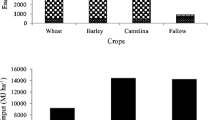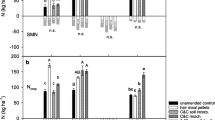Abstract
Accumulation of thin stillage (TS), a byproduct resulting from ethanol production, has led to a need to explore all possible means of its utilization. The objective of this research was to evaluate the effectiveness of TS derived from wheat (Triticum aestivum L.)-based ethanol production plant as a fertilizer. The experiment was conducted over a 2-year period in east-central Saskatchewan, Canada. Treatments included three rates of TS: 50, 100, and 200 kg N ha−1 using two methods of application: broadcast, and incorporation and injection. For comparison, conventional fertilizer urea (46-0-0) was applied at the same rates of N as the TS. Responses of crop yield (wheat and canola (Brassica napus L.), N and P uptake, and apparent N recovery were measured over two growing seasons on a Black Chernozemic soil. For both seasons, at equivalent N rate, the TS produced similar or greater crop yield and nutrient recovery compared to urea fertilizer, especially when injected. This is caused by the presence of other plant nutrients, such as P and S in TS, and its relatively high plant-available NH4 +-N content. The injection of TS appears to be a more effective application method compared to broadcasting, likely through reducing volatile N loss and placing nutrients closer to the growing crop roots when injected in bands in soil. The TS did not show any adverse effect on measured crop parameters even at the high rate of application. The results of this study suggest that land application of TS can be an effective solution for TS management that recycles nutrients in the feedstock grain for the ethanol production.






Similar content being viewed by others
References
Wilkie AC, Riedesel KJ, Owens JM (2000) Stillage characterization and anaerobic treatment of ethanol stillage from conventional and cellulosic feedstocks. Biomass Bioenergy 19:63–102
Bonnardeaux J (2007) Potential uses for distillers grains [Avilabe at: http://www.agric.wa.gov.au/content/sust/biofuel/potentialusesgrains042007.pdf. Virified January 24, 2011. Department of Agriculture and Food, Government of Western Australia, 15
van Haandel AC, Catunda PFC (1994) Profitability increase of alcohol distilleries by the rational use of byproducts. Water Sci Technol 29:117–124
Faust U, Prave P, Schlingmann M (1983) An integral approach to power alcohol. Process Biochem 18:31–37
Mustafa AF, McKinnon JJ, Christensen DA (2000) The nutritive value of thin stillage and wet distillers' grains for ruminants: A review. Asian‐Austral. J Anim Sci 13:1609–1618
Rausch KD, Belyea RL (2006) The future of coproducts from corn processing. Appl Biochem Biotech 128:47–86
Alotaibi KD, Schoenau JJ (2012a) Biofuel production byproducts as soil amendments. In: Lichtfouse E (ed) Organic fertilization, soil quality and human health. Vol 9. Springer, pp 67–91
Cardona CA, Sánchez ÓJ (2007) Fuel ethanol production: Process design trends and integration opportunities. Bioresour Technol 98:2415–2457
España-Gamboa E, Mijangos-Cortes J, Barahona-Perez L, Dominguez-Maldonado J, Hernandez-Zarate G, Alzate-Gaviria L (2011) Vinasses: characterization and treatments. Waste Manag Res 29:1235–1250
Gemtos TA, Chouliaras N, Marakis S (1999) Vinasse Rate, time of application and compaction effect on soil properties and durum wheat crop. J Agric Eng Res 73:283–296
Singh AB, Biswas AK, Pamana S (2003) Effect of distillery effluents on plant and soil enzymatic activities and groundnut quality. J Plant Nutr Soil Sci 166:345–347
Resende AS, Xavier RP, Oliveira OC, Urquiaga S, Alves BJR, Boddey RM (2006) Long-term effects of pre-harvest burning and nitrogen and vinasse applications on yield of sugar cane and soil carbon and nitrogen stocks on a plantation in pernambuco, N E Brazil. Plant Soil 281:339–351
Hati K, Biswas A, Bandyopadhyay K, Misra A (2007) Soil properties and crop yields on a vertisol in India with application of distillery effluent. Soil Tillage Res 92:60–68
Iotaibi KD, Schoenau JJ (2011) Enzymatic activity and microbial biomass in soil amended with biofuel production byproducts. Appl Soil Ecol 48:227–235
Qian P, Schoenau J, Urton R (2011) Effect of soil amendment with thin stillage and glycerol on plant growth and soil properties. J Plant Nutr 34:2206–2221
Alotaibi KD, Schoenau JJ (2012) Greenhouse gas emissions and nutrient supply rates in soil amended with biofuel production by-products. Biol Fertil Soils 49:129–141
Gee GW, Bauder JW (1986) Particle-size analysis. In: Klute A (ed) Method of soil analysis. Part I-Physical and mineralogical methods, 2nd edn. ASA-CSSA-SSSA, Madison, pp 383–411
Stumborg C, Schoenau JJ, Malhi SS (2007) Nitrogen balance and accumulation pattern in three contrasting prairie soils receiving repeated applications of liquid swine and solid cattle manure. Nutr Cycl Agroecosyst 78:15–25
Thomas RL, Sheard RW, Moyer JR (1967) Comparision of conventional and automated procedures for nitrogen, phosphorus and potassium analysis of plant material using a single digestion. Agron J 59:240–243
Technicon Industrial Systems (1978) Ammonium in water and seawater. Industrial Method 154–71 W/B Technicon Industrial Systems, Tarrytown
Bechini L, Marino P (2009) Short-term nitrogen fertilizing value of liquid dairy manures is mainly due to ammonium. Soil Sci Soc Am J 73:2159–2169
Pratt PF, Broadbent FE, Martin JP (1973) Using organic wastes as fertilizers. Calif Agric 27:10–13
Paul JW, Beauchamp EG (1993) Nitrogen availability for corn in soils amended with urea, cattle slurry, and solid and composted manures. Can J Soil Sci 73:253–266
Eghball B, Power JF (1999) Phosphorus- and nitrogen-based manure and compost applications: Corn production and soil phosphorus. Soil Sci Soc Am J 63:895–901
Mooleki SP, Schoenau JJ, Charles JL, Wen G (2004) Effect of rate, frequency and incorporation of feedlot cattle manure on soil nitrogen availability, crop performance and nitrogen use efficiency in east central Saskatchewan. Can J Soil Sci 84:199–210
N'Dayegamiye A, Huard S, Thibault Y (2003) Influence of paper mill sludges on corn yields and N recovery. Can J Soil Sci 83:497–505
N'Dayegamiye A (2006) Mixed Paper Mill Sludge Effects on Corn Yield, Nitrogen Efficiency, and Soil Properties. Agron J 98:1471–1478
Jenkins JW, Sweeten JM, Reddell DL (1987) Land application of thin stillage from a grain sorghum feedstock. Biomass 14:245–267
Malhi SS, Grant CA, Angers DA, Johnston AM, Schoenau JJ, Drury CF (2008) Integrated nutrient management: Experience and concepts from Canada. In: Aulakh CGM (ed) Integrated nutrient management for sustainable crop production. Haworth Press, New York, pp 123–198
Qian P, Schoenau JJ, Karamanos RE (1994) Simultaneous extraction of available phosphorus and potassium with a new test: A modification of Kelowna extraction. Commun Soil Sci Plant Anal 25:627–636
Qian P, Schoenau JJ (2000) Use of ion exchange membrane to assess soil N supply to canola as affected by addition of liquid swine manure and urea. Can J Soil Sci 80:213–218
Paul JW, Zebarth BJ (1997) Denitrification during the growing season following dairy cattle slurry and fertilizer application for silage corn. Can J Soil Sci 77:241–248
Gagnon B, Ziadi N, Grant C (2012) Urea fertilizer forms affect grain corn yield and nitrogen use efficiency. Can J Soil Sci 92:341–351
Eghball B, Sander DH (1989) Band spacing effects of dual-placed nitrogen and phosphorus fertilizers on corn. Agron J 81:178–184
Miller JJ, Beasley BW, Drury CF, Zebarth BJ (2009) Barley yield and nutrient uptake for soil amended with fresh and composted cattle manure. Agron J 101:1047–1059
Huijsmans J, Hol JMG, Vermeulen GD (2003) Effect of application method, manure characteristics, weather and field conditions on ammonia volatilization from manure applied to arable land. Atmos Environ 37:3669–3680
Acknowledgments
Support of the Feed Opportunities from Biofuels program and the Saskatchewan Agriculture Development Fund is greatly appreciated. Field and lab assistance provided by Tom King and Cory Fatteicher during the course of this study is also acknowledged.
Author information
Authors and Affiliations
Corresponding author
Rights and permissions
About this article
Cite this article
Alotaibi, K.D., Schoenau, J.J. & Hao, X. Fertilizer potential of thin stillage from wheat-based ethanol production. Bioenerg. Res. 7, 1421–1429 (2014). https://doi.org/10.1007/s12155-014-9473-1
Published:
Issue Date:
DOI: https://doi.org/10.1007/s12155-014-9473-1




